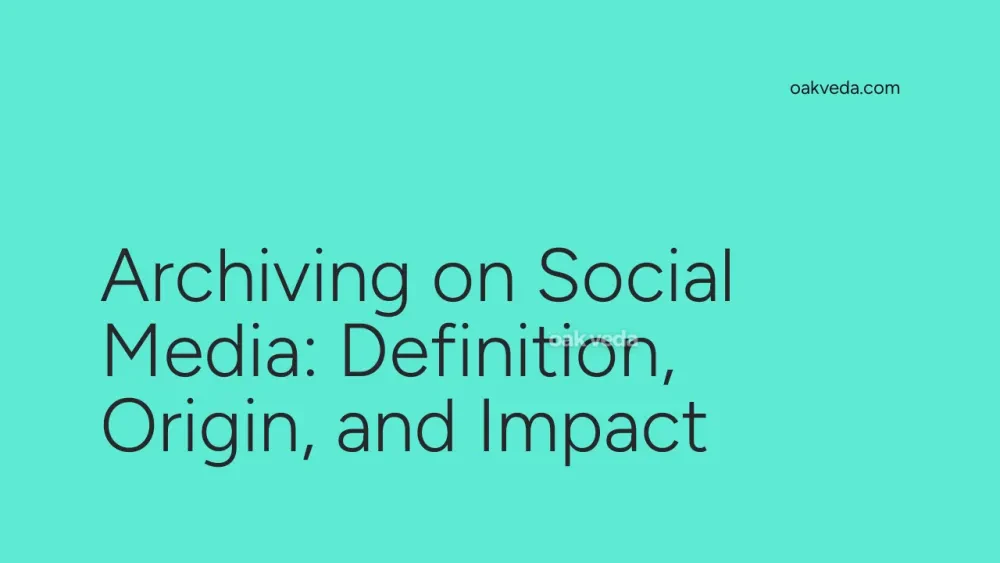
What is Archiving on Social Media?
Archiving on social media refers to the process of preserving and storing content, typically posts or stories, in a hidden or private location within a user's account. This feature allows users to remove content from their public profile or feed without permanently deleting it. Archiving serves as a digital storage solution, enabling users to maintain a curated online presence while retaining access to their past content.
Origin and Development of Social Media Archiving
The concept of archiving on social media platforms emerged as a response to users' growing need for better content management. Instagram, one of the pioneers in this feature, introduced archiving in 2017. Since then, other major platforms like Facebook and Twitter have implemented similar functionalities, recognizing the importance of giving users more control over their digital footprint.
How Social Media Archiving Works
When a user chooses to archive a post or story, the content is moved to a private section of their account, typically called "Archive" or "Archived Posts." This process hides the content from public view, including followers and other users browsing the profile. The archived content remains accessible to the account owner, who can choose to restore it to their public profile at any time.
Types of Social Media Archiving
- Post Archiving: This involves hiding individual posts from a user's main feed or profile grid.
- Story Archiving: Many platforms automatically archive stories after their 24-hour lifespan, allowing users to revisit and potentially reshare them later.
- Highlight Archiving: Some platforms allow users to archive highlight reels, which are curated collections of stories.
Popular Examples of Social Media Archiving
- Instagram: Users can archive both posts and stories, with stories automatically moving to the archive after 24 hours.
- Facebook: The platform offers options to archive posts, making them visible only to the user.
- Twitter: While not called "archiving," users can hide tweets from their profile without deleting them.
- LinkedIn: Professionals can archive posts to maintain a relevant and up-to-date profile.
Impact of Archiving on Social Media Culture
Archiving has significantly influenced how users manage their online presence:
- Content Curation: Users can maintain a polished, relevant profile by archiving outdated or less popular content.
- Digital Memory Preservation: Archiving allows users to keep personal memories without cluttering their public feed.
- Reduced Pressure: The ability to hide posts without deleting them reduces the stress associated with maintaining a perfect online image.
- Flexible Content Strategy: Brands and influencers can rotate content seasonally or based on current trends.
How Brands and Influencers Use Archiving
For businesses and content creators, archiving is a powerful tool in their social media strategy:
- Seasonal Content Management: Brands can archive holiday-specific posts after the season ends, keeping their profile relevant year-round.
- Performance Analysis: By archiving underperforming posts, brands can refine their content strategy without losing valuable data.
- Brand Evolution: As a brand's identity evolves, archiving allows for a seamless transition in visual aesthetics or messaging.
- Content Recycling: Influencers can archive and later resurface evergreen content, maximizing its value over time.
Future Trends Related to Social Media Archiving
As social media continues to evolve, we can expect several trends in archiving:
- AI-Powered Archiving: Platforms may introduce smart archiving features that suggest content to hide based on performance or relevance.
- Enhanced Privacy Controls: Future archiving options might include more granular controls over who can see archived content.
- Cross-Platform Archiving: As users manage multiple social media accounts, we might see tools that allow for centralized archiving across platforms.
- Archiving Analytics: Platforms could provide more detailed insights into archived content, helping users make informed decisions about restoring or permanently deleting posts.
FAQs about Social Media Archiving
-
Can others see my archived posts? No, archived posts are only visible to the account owner.
-
Does archiving affect my engagement rates? Archiving removes the post from public view, so it will no longer receive new engagement. However, it preserves existing likes and comments.
-
Can I restore archived content? Yes, most platforms allow users to unarchive content, restoring it to its original position in the feed or profile.
-
Do archived posts still appear in search results? No, archived posts are removed from public search results on the platform.
-
Is there a limit to how much content I can archive? This varies by platform, but generally, there's no set limit to the amount of content you can archive.
Archiving on social media has revolutionized how users manage their digital presence. By offering a middle ground between keeping content public and permanently deleting it, archiving empowers users to curate their online image while preserving their digital history. As social media continues to play a central role in our lives, features like archiving will undoubtedly evolve, offering even more sophisticated ways to manage our online identities and content.
You may be interested in:
- Boyfriend Effect: Definition, Origin, and Impact on TikTok
- FR (For Real): Definition, Origin, and Impact on Social Media
- Finna: Definition, Origin, and Impact on Social Media
- Social Selling: Definition, Origin, and Impact
- Media Library: Definition, Origin, and Impact on Social Media
- Girlie: Definition, Origin, and Impact on Social Media

